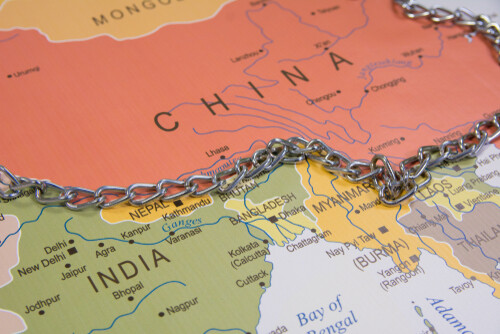Abstract: As Bangladesh is mainly surrounded by India, most of its political decisions are influenced by the latter’s presence. India has been reluctant to resolve different bilateral disputes like border killing, trade imbalance, tax barrier, river disputes, religious agitation, and the Rohingya issue, and it has been alleged to interfere in the domestic politics of Bangladesh. Allegation of Indian interference in the January 07, 2024, National Election of Bangladesh has created an ‘anti-India’ sentiment in Bangladesh. In many instances, India acts as a dominant partner of Bangladesh in exerting its regional strength. Bangladesh relies on the neighbouring giant for economic, technological, and societal developments. On the other hand, the rise of the People’s Republic of China (PRC) in international politics changes the existing structure. Both countries compete against one another in politics, economics, and military aspects, and they cherish the desire to become the regional hegemon. Apparently, the U.S. and other Western powers are not directly engaging in this tug-of-war. The brawling between India and the PRC is reorchestrating the decision-making process of smaller states like Bangladesh in the Asian region. Bangladesh is working towards adapting adjustment strategies in its foreign policy to survive this security dilemma.
Problem statement: How does the strategy of compromises help Bangladesh survive among neighbouring giants like India and China?
So what?: Bangladesh aims to balance the influence of both neighbouring giants with a compromise strategy. This allows the nation to enjoy “spilled-over development,” which is the by-product of its balance between India and the PRC. However, Bangladesh has plenty of resources and opportunities to create an assertive foreign policy to help the country flourish independently. Furthermore, given its geopolitical realities, Bangladesh still needs to compromise with its neighbouring giants.

Source: shutterstock.com/GR/ Stocks
Muddling through the Reality
Bangladesh has played an important role in international politics since its birth in 1971, ending a bloody war of independence against Pakistan. The country is rising in economic, technological, developmental and multilateral contexts. Human development and other social indicators are similarly rising. Bangladesh’s average GDP growth was a remarkable 6.4% during 2016-21, the digital economy grew from $1.7 billion in 2019 to $3.5 billion in 2022, women’s participation in the job sectors has increased from 36.3% to 42.68% in 2022-23, and crisis with unemployment has come down from 4.2% to 3.6%.[1] The Human Development Index of Bangladesh improved from 0.394 to 0.632 from 1990 to 2019.[2] Notably, Bangladesh is a very important development partner of the United States of America. The U.S. tries to maintain a thoroughly cooperative relationship with Bangladesh. However, due to the rise of the People’s Republic of China (PRC), the U.S. indirectly guides Bangladesh to join the Anti-China blocs and alliances such as the Indo-Pacific Economic Forum (IPEF) and Quadrilateral Security Dialogue (QUAD).[3] South Asian experts such as Michael Kugelman pointed out that in spite of its non-align foreign policy, Bangladesh appears to be moving closer to the Indo-Pacific Strategy pursued by the U.S. and its allies.[4] Although the U.S. is not directly involved in the political context of Bangladesh, the superpower closely observes the moves Bangladesh take.[5]
The U.S. indirectly guides Bangladesh to join the Anti-China blocs and alliances such as the IPEF and QUAD.
The U.S. needs countries near and around the Pacific to ensure ‘America’s Pacific Century’. In this regard, Nayanima Basu opined, “In a major foreign policy shift, the Donald Trump administration is now looking at countries like Bangladesh, Sri Lanka and Maldives among others, not just for the purpose of business, but as key strategic partners under the Indo-Pacific construct, which is largely aimed at containing China”. The Biden administration is also on the same track.[6] Under this strategic framework, the U.S. constantly observes countries near and around the Pacific, including Bangladesh. On the other hand, India influences Bangladesh’s domestic and international politics since it geostrategically surrounds it. Historically, the countries are outrightly related to each other, as India gave full-fledged support during Bangladesh’s liberation war against Pakistan. Furthermore, ethnic similarities exist between Bangladesh and West Bengal inhabitants of India. Due to these issues, India, being a crucial factor, influences Bangladesh’s politics.[7] As such, the India factor is one of the significant elements in Bangladeshi foreign policy.
The India Factor
Critical factors between Bangladeshi and Indian contemporary foreign relations include but are not limited to border killing, trade gap, tax barrier, river disputes, Citizenship (Amendment) Act (CAA), religious agitation, Rohingya issue and PRC fear. Border killings are a heated issue for both countries. Innocent Bangladeshis are being killed in the India- Bangladesh border, which is 4,096 km long. Admittedly, India’s Border Security Force (BSF) follows ‘shoot-to-kill’ policies against unarmed Bangladeshi civilians who attempt to cross the border illegally.[8] Between 2000 and 2019, at least 1,185 unarmed Bangladeshis were killed by the BSF along the border.[9] In 2022 and 2021, BSF killed at least 23 and 18 Bangladeshis. From 2021 to 2023, At least 60 of the 73 Bangladeshis were shot, while six were tortured to death.[10]
India’s Border Security Force follows ‘shoot-to-kill’ policies against unarmed Bangladeshi civilians who attempt to cross the border illegally.
The Teesta River water-sharing dispute, the most important bilateral issue between the two states mired in conflict since 1947, has not been addressed by the Indian governments, including the Modi regime.[11] Teesta is a transborder river shared by both countries. It originates in Sikkim, flows through West Bengal, and joins the Brahmaputra River (known as the Jamuna in Bangladesh) before eventually flowing into the Bay of Bengal.[12] Teesta is crucial to the lives of 30 million people in both countries for irrigation, drinking, fishing, energy, and other agricultural and domestic purposes. Bangladesh Water Development Board reported that the average annual flow of the Teesta at Dalia Point was 6,710 cusecs, which decreased to 2,000 cusecs after the Gazaldoba barrage in West Bengal, India, went into operation in 1995.[13] It exacerbated the living conditions of the Bangladeshi people living in the river basin. According to section 253 of the Indian constitution, the central government has the power to make any international treaty. Still, in the case of Teesta River water sharing, the central government blames the state government for not addressing the problem.[14] Arguably, Bangladesh suggested providing transit benefits to India in return for Teesta River water, known as the ‘transit in exchange of river water’ policy.[15] In return for this benefit towards India, the Teesta River water issue is not yet resolved.
Dr Mustafizur Rahman, Distinguished Fellow at the Centre for Policy Dialogue (CPD), mooted that the Teesta River water sharing acts as a ‘bargaining chip’ and “is working as a deterrent to realising newer opportunities of deepening bilateral economic ties. Bangladesh has gone a long way in addressing one of India’s key concerns, security, and has been forthcoming in offering transit facilities. It can justifiably expect the Indian central government to do its best to arrive at a deal with the West Bengal state government to resolve the issue”.[16] Receiving the Teesta River water is a fundamental right for Bangladesh that has been denied even at the cost of trade-off with transit benefits.[17] In the case of immigration and human security issues, India, under the Bharatiya Janata Party (BJP) rule, shows hostility towards Bangladeshis and Muslims. According to India Hate Lab, 668 cases of anti-Muslim hate speeches were recorded in 2023. 75% of the total instances in 2023 took place in BJP-ruled states. 36% of the events included a direct call of violence against Muslims. In 15% of the total events, BJP leaders were involved in delivering hate speeches.[18] During the first 3 years of the Modi era religious-based, religious-based hate crimes against Muslims increased by 30 per cent. This rate has doubled since his re-election in 2019.[19] Such Islamophobia in India is agitating the Muslim-majority Bangladeshi people. The rising ultra-nationalists in India are creating friction in social harmony using populist ideologies like Hindutva. As a result of such ideology, the BJP government announced the Citizenship (Amendment) Act (2019), which agitated Bengalis and Muslims of both countries.[20]
Regarding the regional political economy, scholars like Anu Muhammad, a renowned Bangladeshi economist, argue that India made Bangladesh an intermediary conservative market to serve its narrow self-interest, creating a massive difference between the countries’ resources.[21] He coined India as a ‘Sub-Imperialist’ within the global capitalist system and remarked, “Indian big business has access to huge potential market in Bangladesh. India’s presence is very high in every sector in Bangladesh. It is trying to monopolise each of those sectors, started utilising aid or credit, very well-known instruments of imperialist control and influence. Bangladesh is entering into the ambit of India’s military, political and economic domination on a scale not seen before.”[22] This falls under the principles of dependency theory, where the orchestration of Bangladesh and India appears to be much like the relationship between the periphery and core.
India made Bangladesh an intermediary conservative market to serve its narrow self-interest, creating a massive difference between the countries’ resources.
On the other hand, scholars argue that India itself is the victim of such orchestration at an international level, becoming the periphery in the bigger picture.[23] Following its Kautilya doctrine, India historically used surrounding smaller nations as buffer states to exist as the imperious ones.[24] Similar hegemonic expansionism coined as ‘Middle Kingdom Syndrome’ can also be traced in Chinese politics. The PRC historically glorifies itself as a hegemonic civilisation where it is considered the centre of the world.[25] Indian Kautiliyan theory of Raja Mandala proposes that constant predominance in the immediate neighbourhood is the way to become a conventional power at the system level.[26] These countries around India often shoulder the impacts of India’s rise on their economy and security. Modi’s foreign policy often presents his intentions as Kautiliyan Chakravarti, the all-encompassing ideal ruler of the entire Indian subcontinent.[27] An enormous trade gap between India and Bangladesh is clearly visible in terms of the above-noted market strategy.
One of the most controversial topics, which is a textbook example of genocide, discussed around the world in recent times, the Rohingya issue, is a burden for Bangladesh and still unrecognised by India.[28] Although India focuses intensely on the “Act East Policy” intending to include the Southeast region of Asia in the regional political and economic governance, it can be seen as rhetoric due to India’s indifference towards the Rohingya issue.[29]
All these issues generate some form of hostility among the Bangladeshis and Indians. However, the geostrategic and historical realities made India superior to Bangladesh, which cannot be denied. Although Bangladesh is actively involved in a functional relationship with the country, there has been a slight change in Bangladeshi foreign policy. The influences exerted by India just beyond the borders of Bangladesh regarding the trade gap, ultra-nationalism, and militarisation- made Bangladesh fall into a security dilemma. From the 2014 Maritime dispute achievement of Bangladesh against India, the former has been trying to be bold enough to express its stances towards India regarding issues like CAA, religious agitation created by BJP, land boundary victories, and Rohingya issues.[30]
The influences exerted by India just beyond the borders of Bangladesh regarding the trade gap, ultra-nationalism, and militarisation- made Bangladesh fall into a security dilemma.
Bangladesh is also climbing up the social indicator, leaving Pakistan behind and is on the verge of going ahead of India. According to the “Freedom and Prosperity in Bangladesh” report prepared by the Atlantic Council’s Freedom and Prosperity Centre, Bangladesh ranked 99th in the Prosperity Index among 164 countries. In contrast, India and Pakistan ranked 146th and 150th, respectively.[31] As per another report by The Heritage Foundation, in the Economic Freedom Index 2021, Bangladesh is ranked 120th, India is 121st, and Pakistan is 152nd.[32] Bangladesh’s GDP per capita in PPP is USD 8,670 in 2023, while India’s USD 9,180 and Pakistan’s USD 6770.[33] As a result of such developments, India and other major powers recognise and respect Bangladesh. India would not want to let go of its valuable neighbour but rather closely observe Bangladesh’s changing foreign policy dimensions.[34]
The PRC in the Big Picture
The PRC is taking a drastic leap towards the international arena from every possible sector. Even in this South Asian region, the PRC plays an effective role through the Belt and Road Initiative (BRI). The country is building up a “Chinese consciousness” throughout the Indian Ocean region concerning political, economic and military development through the initiative stretching to the Arabian Sea. This development is often considered a security dilemma internationally. Chinese influence in states like Sri Lanka, Maldives, Myanmar, Pakistan, Djibouti, Oman and many others is visibly evident nowadays. The immense Chinese control over the Malacca Strait proves the country’s dominance over global maritime chokepoints. Although scholars argue that Chinese interest lies only within economy and geostrategy,[35] India alleges the BRI is a part of Chinese aggression, which the country is exhibiting through building a string of pearls around India.[36]
The heavy Chinese investment in different South Asian countries creates an immense debt trap within the developing and underdeveloped countries. [37] Furthermore, India is struggling with its “Act East Policy ” as the PRC historically exerts the highest level of dominance in the region.[38] Nevertheless, the PRC has greater influence over India’s neighbouring countries and engages in disputes with India regarding border issues: border killings along with heavy militarisation and infrastructural construction near the Line of Actual Control (LAC). The PRC also enjoys the benefits of a vast trade gap with India. India, the U.S. and its allies are arranging different anti-China campaigns. The most important are the FOIP or Free and Open Indo Pacific and Quadrilateral Security Dialogue or QUAD. The countries such as the U.S., Japan, India, Australia and the Philippines are expressing their sheer hostility against the PRC through these arrangements.[39]
India is struggling with its “Act East Policy ” as the PRC historically exerts the highest level of dominance in the region.
Arguably, the Chinese desire to become the hegemon and/or its emerging presence to deter U.S. hegemony threatens the Indian interests.[40] That is why India is trying to influence the remaining neighbouring countries in an attempt not to fall under Chinese hegemony. Bangladesh could be a prime example of such a dilemma. Recently, the PRC was supposed to invest heavily in different mega projects in Bangladesh. Due to India’s “carrot and stick policy”, Bangladesh had to back out of this situation. India is also influencing Bangladesh to join the FOIP and QUAD as a response against Chinese hegemony.[41] India strategically supports the U.S.’ FOIP in the form of Free, Open and Inclusive Indo-Pacific (FOIIP) and ‘Act East Policy’.[42] With its ‘Neighbourhood First’ policy, India wants neighbouring countries to bandwagon with Indo-Pacific policies. Despite all that, the PRC and India have a functional relationship of “Competitive Collaboration” through trade dependency, regional institutions like the National Development Bank (NDB), Brazil, Russia, India, China and South Africa (BRICS) and the Shanghai Cooperation Organization.[43]
Resolve to Survive
A particular decision-making process influences Bangladesh’s security policies. Major powers in regional politics are playing Bangladesh.[44] To muddle through this reality, the country tends towards pro-status-quo decision-making models. The decision-making process of Bangladesh is best described by incrementalism, the theory which explains that “decisions are made not in the light of clear cut objectives but through small adjustments dictated by changing circumstances”.[45] David Braybrooke and Charles Lindblom (1963) termed incremental models as “disjointed incrementalism,” which is summed up as the “Science of Muddling Through” by Lindblom (1959). “This position holds that, in practice, decisions tend to be made on the basis of inadequate information and low levels of understanding and this discourages decision makers from pursuing bold and innovative courses of action. Policy making is therefore a continuous, exploratory process: lacking overriding goals and clear cut ends, policy makers tend to operate within an existing pattern or framework adjusting their position in the light of feedback in the form of information about the impact of earlier decisions. Indeed, incrementalism may suggest a strategy of avoidance or evasion, policy makers being inclined to move away from problems rather than trying to solve them. “muddling through” at least implies responsiveness and flexibility, consultation and compromise. However, the model is clearly best suited to situations in which policy makers are more inclined towards inertia rather than innovation. It thus explains the foreign policy trends of pro-status-quo states more easily than those that seek to revise or overturn the status-quo.”[46]
Bangladesh gave up its fundamental rights in the face of Indian dominance. Bangladesh uses the “Strategy of Avoidance and Compromise” to muddle through issues like being India’s conservative market, having a trade deficit, and giving up on serious issues like the Rohingya crisis, the Teesta River dispute, and border killings. Nevertheless, Bangladesh still has a positive impact on international politics nowadays.
Bangladesh uses the “Strategy of Avoidance and Compromise” to muddle through issues like being India’s conservative market, and giving up on serious issues like the Rohingya crisis and border killings.
While scholars such as Dr Iftekhar Ahmed Chowdhury, Principal Research Fellow at the Institute of South Asian Studies, National University of Singapore and Anu Muhammad indicate that Bangladeshi foreign policy revolves around the “incremental foreign policy model,” the nation needs polity construction in its domestic arena to become more assertive in international politics. This polity construction could mend the political splits and class struggle in the domestic political realm of Bangladesh through compromise, accommodation and agreement. Also, in the international arena, Bangladesh can use regional institutions like the Bay of Bengal Initiative for Multi-Sectoral Technical and Economic Cooperation (BIMSTEC) and the South Asian Association for Regional Cooperation (SAARC). Although the SAARC is almost defunct, reforms like bilateral negotiations and the inclusion of other members in the platform might make this institution the best option for regional cooperation.[47]
Power Balancing
Bangladesh has adjusted its policies to balance among its neighbouring giants like India and China. This approach can be asserted as “incremental model of foreign policy,”. Dr Iftekhar Ahmed Chowdhury recounted this foreign policy approach of Bangladesh as “tactical reactions to global situation rather than a strategic response as a product of careful calculations. In other words, it tends to be reactive rather than pro-active”.[48] Although Bangladesh has been outwardly bold enough to point out its national issues via international platforms, due to the denial of polity constructions within its domestic realm and geopolitical realities, it always inclines towards a strategy of compromise in its foreign policy. Unsettled international issues like the Teesta River water sharing dispute, transit issues, trade deficit, the Rohingya crisis, border killings, and religious agitation have always favoured India. This Indian factor is a burden for Bangladeshi foreign policy.
Unsettled international issues like the Teesta River water sharing dispute, transit issues, trade deficit, the Rohingya crisis, border killings, and religious agitation have always favoured India.
The PRC primarily focuses on its geopolitical and economic achievements rather than mere border issues with India.[49] Stretching far ahead, the PRC is trying to persuade Bangladesh to recognise the country’s strength to succeed with the BRI in global politics. However, considering the overarching impacts of the PRC’s debt-trap diplomacy, it is a matter of argument whether it will be healthier for Bangladesh to bandwagon the BRI projects. Other important partners like the U.S., Myanmar, Pakistan and other states closely observe the status change among the three important countries. Considering all these realities, Bangladesh is formulating a strategy of compromises in its foreign policy, which are tactical reactions to the global situation rather than a strategic response.
Mohammad Istiaq Jawad holds a Master’s in International Relations. The independent researcher is a specialist in the analysis of Bangladesh’s foreign policy and nationalism as well as an expert in the financial sector. The views contained in this article are the author’s alone.
[1] Indrajit Kumar, 2023, “Bangladesh economy: A case of “development miracle”,” The Business Standard.
[2] Selim Jahan, 2024, “Improving the Human Development Index: The Bangladesh perspective,” The Daily Star.
[3] Sharin Shahjahan Naomi, 2023, Bangladesh foreign policy approach should shift to multi-alignment, Institute for Security and Development Policy, https://www.isdp.eu/bangladesh-foreign-policy-approach-should-shift-to-multi-alignment/.
[4] Michael Kugelman, 2023, “Bangladesh Tilts Toward the U.S. in the Indo-Pacific,” Foreign Policy Magazine, last accessed May 20, 2024, https://foreignpolicy.com/2023/03/30/bangladesh-us-indo-pacific-strategy-china/.
[5] Prof. Shahab Enam Khan, 2020, Bangladesh Foreign Relations with Prof. Shahab Enam Khan, https://www.youtube.com/watch?v=vK3_ySSETis.
[6] Nayanima Basu, 2020, “India keen to “leverage” US focus on its neighbourhood as they stand up against China,” The Print, last accessed May 20, 2024, https://theprint.in/diplomacy/india-keen-to-leverage-us-focus-on-its-neighbourhood-as-they-stand-up-against-china/525014/.
[7] Gaurav Bhattarai and Manish Jung Pulami, 2020, “The Neo-Kautiliyan Facet of Modi’s Neighbourhood Policy: A Non-Western Perspective,” Stosunki Międzynarodowe – International Relations, 2(56), 39–65. doi:10.7366/020909612202003.
[8] Brad Adams, 2011, “India’s shoot-to-kill policy on the Bangladesh border,” The Guardian, last accessed May 17, 2024, https://www.theguardian.com/commentisfree/libertycentral/2011/jan/23/india-bangladesh-border-shoot-to-kill-policy?INTCMP=SRCH.
[9] Rumi Kawser, 2020, “Bangladesh sees highest border deaths in 10 years,” Dhaka Tribunes, December 22, 2020, https://www.dhakatribune.com/bangladesh/234048/bangladesh-sees-highest-border-deaths-in-10-years.
[10] Shariful Islam, 2024, “Bangladesh-India Border: Zero death pledge rings hollow,” The Daily Star, https://www.thedailystar.net/news/bangladesh/news/bangladesh-india-border-zero-death-pledge-rings-hollow-3562196.
[11] Khaled Mohiuddin, 2020, চীন, ভারতের মোড়লিপনা, বাংলাদেশের লাভ-ক্ষতির হিসেব., last accessed July 08, 2021, https://www.youtube.com/watch?v=3I3AF7X8nDI.
[12] Golam Rosul, 2024, “Will we ever get the Teesta back?,” The Daily Star, last accessed May 18, 2024, https://www.thedailystar.net/opinion/views/news/will-we-ever-get-the-teesta-back-3571031.
[13] Bangladesh Water Development Board (BWDB), Md. Arifuzzaman Bhuyan and Sardar Udoy Raihan, 2020 Annual Flood Report 2020. Dhaka: Bangladesh Water Development Board (BWDB).
[14] Khaled Mohiuddin, 2020, বাংলাদেশ-ভারত সম্পর্কে মমতা ফ্যাক্টর., https://www.youtube.com/watch?v=oMPaRMuja4Y.
[15] Nazrul Islam, 2024 Teesta project: Does Bangladesh have no alternative to China and India?, last accessed May 22, 2024, https://en.prothomalo.com/opinion/wiflcjq6st.
[16] Masum Billah and Dr. Mustafizur Rahman (2020), “Making Teesta deal a bargaining chip won’t be wise,” The Business Standard. Dhaka, https://www.tbsnews.net/interviews/making-teesta-deal-hostage-stall-other-initiatives-wont-be-wise-119938.
[17] Nazrul Islam, 2024 Teesta project: Does Bangladesh have no alternative to China and India?, [Preprint]. Available at: https://en.prothomalo.com/opinion/wiflcjq6st.
[18] India Hate Lab, 2024 Report 2023: Hate Speech Event in India. Rep, https://indiahatelab.com/2024/02/25/hate-speech-events-in-india-2023-annual-report/.
[19] Harsh Mander, 2018, “New Hate Crime Tracker in India Finds Victims Are Predominantly Muslims, Perpetrators Hindus,” Scroll, (November 13, 2018), retrieved from https://scroll.in/article/901206/new-hate-crime-tracker-in-india-finds-victims-are-predominantly-muslims-perpetrators-hindus.
[20] Shekhar Gupta, 2021, Modi mends ties with Dhaka, Gandhi Peace Prize for Bangabandhu Mujibur Rahman, his legacy & impact, last accessed August 14, 2021,https://www.youtube.com/watch?v=S8CTQ69-Td8.
[21] Mojibur Rahman, 2023, ‘বাংলাদেশ এ অঞ্চলের বড় বাণিজ্যকেন্দ্র হবে’, Prothom Alo. Dhaka, 12–12.
[22] Manoranjan Pegu and Anu Muhammad (2010), ‘PERIPHERAL ECONOMY, GLOBAL CAPITAL AND MOVEMENTS IN BANGLADESH’, Centre Tricontinental (CETRI).
[23] Shekhar Gupta, 2021, Modi mends ties with Dhaka, Gandhi Peace Prize for Bangabandhu Mujibur Rahman, his legacy & impact, last accessed August 14, 2021, https://www.youtube.com/watch?v=S8CTQ69-Td8.
[24] প্রতিবেশীদের কাছ থেকে সুবিধা আদায় করছে ভারত (2024) Prothomalo, https://www.prothomalo.com/politics/7pl559j1gb.
[25] Sakshi Soni (2020), China’s Middle Kingdom syndrome: A hegemonic road towards expansionism, brillopedia, https://www.brillopedia.net/post/china-s-middle-kingdom-syndrome-a-hegemonic-road-towards-expansionism.
[26] C. Raja Mohan, 2007, “India’s Neighbourhood Policy: Four Dimensions,” Indian Foreign Affairs Journal, 2(1).
[27] Gaurav Bhattarai and Manish Jung Pulami, 2020, “The Neo-Kautiliyan Facet of Modi’s Neighbourhood Policy: A Non-Western Perspective,” Stosunki Międzynarodowe – International Relations, 2(56), 39–65. doi:10.7366/020909612202003.
[28] Khaled Mohiuddin, 2020, চীন, ভারতের মোড়লিপনা, বাংলাদেশের লাভ-ক্ষতির হিসেব, last accessed July 08, 2021, https://www.youtube.com/watch?v=3I3AF7X8nDI; and Shekhar Gupta, 2021, Modi mends ties with Dhaka, Gandhi Peace Prize for Bangabandhu Mujibur Rahman, his legacy & impact, last accessed August 14, 2021,https://www.youtube.com/watch?v=S8CTQ69-Td8.
[29] Amena Mohsin, 2018, Deepto Talk Show: চীন-ভারত টানাপোড়েন ও দক্ষিণ এশিয়ার রাজনীতি., last accessed September 13, 2021, https://www.youtube.com/watch?v=xHX7o9Qhi7o.
[30] Shekhar Gupta, 2021, Startling findings in Pew survey on religion, tolerance, nationalism and segregation in India, last accessed August 15, 2021, https://www.youtube.com/watch?v=xCNV1vtV2HU.
[31] The Business Standard, 2024, “Bangladesh surpasses India, Pakistan in prosperity but lags in freedom,” April 16, 2024, https://www.tbsnews.net/bangladesh/bangladesh-surpasses-india-pakistan-prosperity-lags-freedom-829071.
[32] The Daily Star, 2023, “Bangladesh now a case study of economic uplift in world,” July 22, 2023, https://www.thedailystar.net/business/economy/news/bangladesh-now-case-study-economic-uplift-world-3376181.
[33] Jahangir Shah, 2023, “Bangladesh edges Pakistan, India in per capita GDP,” Prothom Alo, December 16, 2023, https://en.prothomalo.com/business/gsuqrsp6i0.
[34] Khaled Mohiuddin, 2020, চীন, ভারতের মোড়লিপনা, বাংলাদেশের লাভ-ক্ষতির হিসেব., last accessed July 08, 2021, https://www.youtube.com/watch?v=3I3AF7X8nDI.
[35] Khaled Mohiuddin, 2020, চীন ভারত সংঘাতে হারছে কে, জিতছে কারা., last accessed October 09, 2021, https://www.youtube.com/watch?v=HJyxQb6doNU.
[36] Cmde Ranjit B Rai, 2013, “China’s String of Pearls vs India’s Iron Curtain,” Indian Defence Review, last accessed May 19, 2024, https://www.indiandefencereview.com/news/chinas-string-of-pearls-vs-indias-iron-curtain/.
[37] Brahma Chellaney, 2017, “China’s Debt-Trap Diplomacy,” Project Syndicate, last accessed May 20, 2024, https://www.project-syndicate.org/commentary/china-one-belt-one-road-loans-debt-by-brahma-chellaney-2017-01.
[38] Amena Mohsin, 2021. Tritiyo Matra Episode 6306 | Professor Amena Mohsin | Ambassador S M Rashed Ahmed Chowdhury, last accessed July 16, 2021, https://www.youtube.com/watch?v=XWDhSGAk8JM.
[39] Michael D. Swaine, 2018, “Creating an Unstable Asia: the U.S. “Free and Open Indo-Pacific” Strategy,” Carnegie Endowment for International Peace, last accessed May 19, 2024, https://carnegieendowment.org/posts/2018/03/creating-an-unstable-asia-the-us-free-and-open-indo-pacific-strategy?lang=en.
[40] Niana Singh, 2022, “China’s Struggle for Hegemony in a Multiplex World Order : The Case of South Asia,: LSE (London School of Economics and Politics), https://blogs.lse.ac.uk/southasia/2022/03/11/chinas-struggle-for-hegemony-in-a-multiplex-world-order-the-case-of-south-asia/.
[41] Sufian Siddique, 2023, “Can Bangladesh-India Work Together In Light Of Indo-Pacific Strategy?,” Fresh Angle International, last accessed May 19, 2024, https://freshangleng.com/28732/can-bangladesh-india-work-together-in-light-of-indo-pacific-strategy.
[42] Rahul Roy Chaudhury, 2018, “Debate: India’s “Inclusive” Indo-Pacific Policy Seeks to Balance US, China,” The Wire, last accessed May 19, 2024, https://thewire.in/diplomacy/indias-inclusive-indo-pacific-policy-seeks-to-balance-relations-with-the-us-and-china.
[43] Amena Mohsin, 2018. Deepto Talk Show: চীন-ভারত টানাপোড়েন ও দক্ষিণ এশিয়ার রাজনীতি., last accessed September 13, 2021, https://www.youtube.com/watch?v=xHX7o9Qhi7o; and Khaled Mohiuddin, 2020. চীন ভারত সংঘাতে হারছে কে, জিতছে কারা., last accessed October 09, 2021, https://www.youtube.com/watch?v=HJyxQb6doNU.
[44] Cookson, F. and Joehnk, T.F., 2018, ”China and India’s geopolitical tug of war for Bangladesh”, East Asia Forum, last accessed May 20, 2024, https://eastasiaforum.org/2018/04/11/china-and-indias-geopolitical-tug-of-war-for-bangladesh/.
[45] Andrew Heywood, 2011. Global Politics. Palgrave Macmillan.
[46] Charles Lindblom, 1959. Science of Muddling Through. Public Administration Review, 19; and David Braybrooke and Charles Lindblom, 1963. A Strategy of Decision: Policy Evaluation as a Political Process. New York: Collier Macmillan.
[47] Rahman Jahangir, 2016, “Let Bangladesh help revive SAARC,” The Financial Express, last accessed May 19, 2024, https://thefinancialexpress.com.bd/views/columns/let-bangladesh-help-revive-saarc.
[48] Iftekha Ahmed Chowdhury, 2018, “Balancing Bangladesh’s foreign policy,” The Daily Star last accessed May 19, 2024, https://www.thedailystar.net/news/opinion/perspective/balancing-bangladeshs-foreign-policy-1619698.
[49] Khaled Mohiuddin, 2020, চীন ভারত সংঘাতে হারছে কে, জিতছে কারা., last accessed October 09, 2021https://www.youtube.com/watch?v=HJyxQb6doNU.





